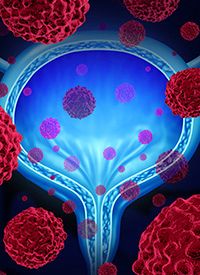Article
FOLFIRINOX Provides Prolonged PFS Benefit Over Gemcitabine in Locally Advanced Pancreatic Carcinoma
Author(s):
Treatment with FOLFIRINOX resulted in a significantly longer progression-free survival than that achieved with gemcitabine in patients with locally advanced pancreatic carcinoma, meeting the primary end point of the phase 3 NEOPAN trial.

Treatment with FOLFIRINOX (leucovorin, fluorouracil, irinotecan, and oxaliplatin) resulted in a significantly longer progression-free survival (PFS) than that achieved with gemcitabine in patients with locally advanced pancreatic carcinoma, meeting the primary end point of the phase 3 NEOPAN trial (NCT02539537).1 However, no significant difference in overall survival (OS) was observed between the arms.
Data presented during the 2022 ESMO Congress showed that at a median of 41.1 months, the median PFS with FOLFIRINOX (n = 85) was 9.7 months (95% CI, 7.0-11.7) vs 7.5 months (95% CI, 6.1-9.2) with gemcitabine (n = 86). The median OS in the investigative arm was 15.1 months (95% CI, 11.9-20.4) vs 15.6 months (95% CI, 12.5-18.7) in the control arm.
“This lack of difference in OS may be due to different factors,” Michel Ducreux, MD, PhD, lead study author and head of the Gastrointestinal Oncology Unit and Gastrointestinal Oncology Tumor Board at Gustave Roussy in Villejuif, France, said in a presentation of the data. “[Specifically, this could be because] treatments with some efficacy [were used] in the metastatic phase—FOLFIRINOX in particular in the gemcitabine arm, [and] very few patients [were] undergoing secondary surgery, reflecting a patient population with very advanced local [disease].”
NEOPAN enrolled patients with unresectable, locally advanced pancreatic carcinoma who had an ECOG performance status of 0 or 1. A total of 171 participants were randomly assigned 1:1 to receive FOLFIRINOX for 12 cycles of 2 weeks or gemcitabine for 6 cycles of 4 weeks. Tumors were examined until patients experienced progressive disease; this was done every 8 weeks for the duration of 2 years and every 12 weeks thereafter.
In addition to PFS serving as the primary end point of the trial, key secondary objectives included serious toxicities, overall survival, objective response rate, and disease control rate.
The median age of patients on the trial was 68 years (range, 42-84), and 50% were male. Moreover, 44% of patients had an ECOG performance status of 0 and 56% had a status of 1; this information was missing in 1 patient. Fifty-six percent of patients had histological disease, and 99% had adenocarcinoma.
Additionally, 48% had vascular invasion in the superior mesenteric artery, 50% had it in the celiac trunk, 25% had it in the portal vein, and 40% had it in the mesenteric vein. Most patients did not undergo biliary bypass (71%) or digestive bypass (98%) surgery.
Additional data showed that subsequent treatments received before disease progression in the investigative and control arms included chemotherapy (33% vs 41%), radiotherapy (9% vs 15%), chemoradiation (13% vs 13%), and surgery (3% vs 4%).
Twenty-seven percent (n = 23) of patients received FOLFIRINOX when they progressed after having received gemcitabine. In the investigative and control arms, respectively, patients who experienced disease progression subsequently received chemotherapy (48% vs 62%), radiotherapy (2% vs 7%), or chemoradiotherapy (6% vs 2%).
In terms of safety, all patients on the gemcitabine arm experienced at least 1 grade 1 adverse effect (AE) vs 98% of those on the FOLFIRINOX arm; 95% vs 96%, respectively, experienced at least 1 grade 2 AE, 71% vs 86% had at least 1 grade 3 AE, 22% vs 20% had at least 1 grade 4 AE, and 8% vs 1% had at least 1 grade 5 AE.
In the FOLFIRINOX arm, the most common toxicities were nausea (27%, grade 1; 35%, grade 2, 12%, grade 3), vomiting (20%, grade 1; 21%, grade 2; 10%, grade 3; 1%, grade 4), anemia (51%, grade 1; 21%, grade 2; 5%, grade 3), neutropenia (12%, grade 1; 21%, grade 2; 12%, grade 3; 1%, grade 4), febrile neutropenia (1%, grade 1; 1%, grade 2; 2%, grade 3), thrombopenia (55%, grade 1; 10%, grade 2; 5%, grade 3; 1%, grade 4), fatigue (26%, grade 1; 35%, grade 2; 18%, grade 3), and fever (10%, grade 1; 5%, grade 2; 2%, grade 3).
“Further investigations are underway to try to explain these results, especially analysis of quality-of-life data,” Ducreux concluded.
Reference
- Ducreux MP, Desgrippes R, Rinaldi Y, et al. PRODIGE 29-UCGI (NEOPAN): a phase III randomized trial comparing chemotherapy with folfirinox or gemcitabine in locally advanced pancreatic carcinoma (LAPC). Ann Oncol. 2022;33(suppl 7):S1136. doi:10.1016/j.annonc.2022.07.1428









